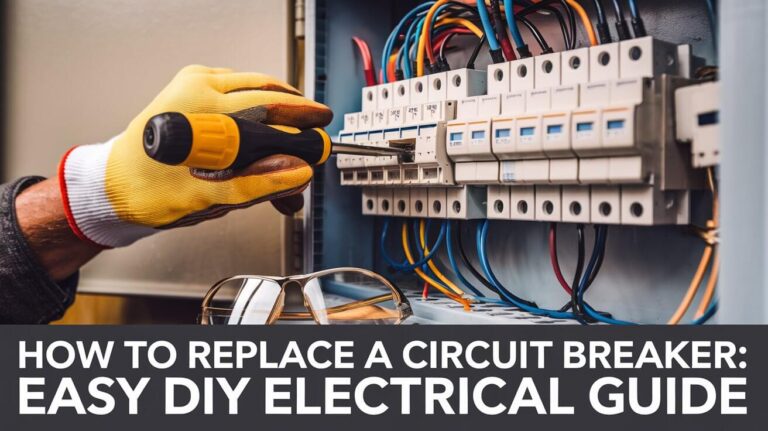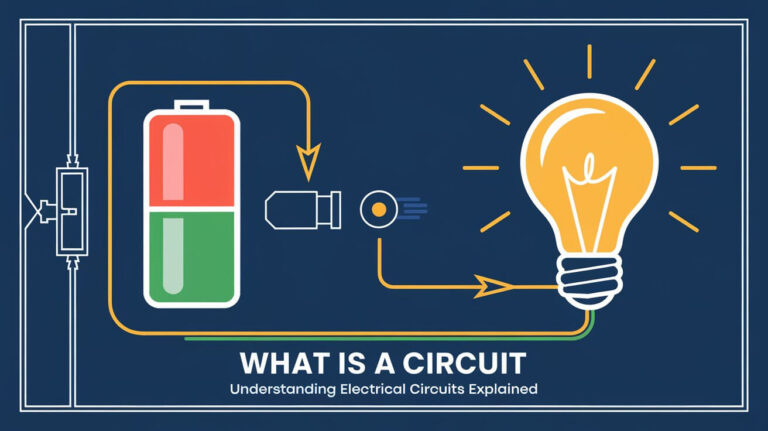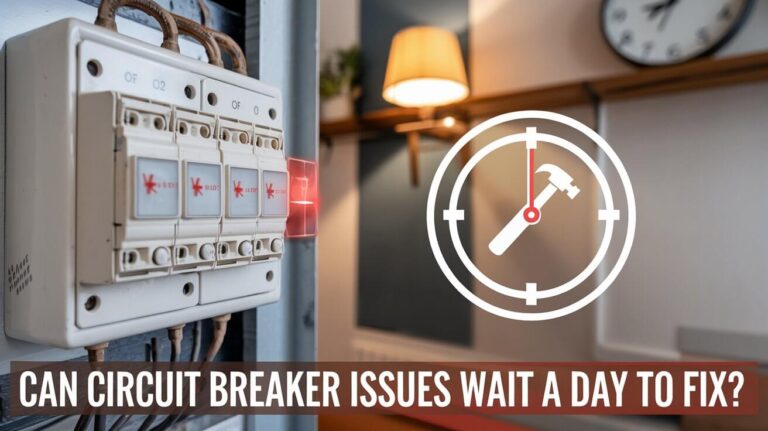How Many Outlets on a 20 Amp Circuit? Full Guide & Tips

If you’re wondering how many outlets you can safely install on a 20-amp circuit, the general recommendation is 10 to 13 outlets. However, the answer isn’t set in stone and depends on various factors, such as the types of devices you plan to plug into those outlets. This article will walk you through everything you need to know about 20-amp circuits, including how to calculate load, best practices for safe outlet use, and how to avoid common issues like circuit overload.
What is a 20-Amp Circuit?
A 20-amp circuit is designed to handle a total of 20 amps of electrical current at once. In homes, these circuits are typically found in areas like kitchens, bathrooms, and garages where power-hungry appliances like microwaves, refrigerators, and hairdryers are commonly used. This type of circuit uses 12-gauge wire, which is thicker than the 14-gauge wire typically used for 15-amp circuits. Thicker wire ensures that the circuit can safely carry the higher electrical load required.
The Difference Between 15-Amp and 20-Amp Circuits
While 15-amp circuits are more common in general living areas like bedrooms and living rooms, 20-amp circuits are better suited for areas that require more power. A key difference between the two is the type of outlets they support. A 20-amp outlet has a distinctive T-shaped slot and can handle more electricity than a 15-amp outlet.
NEC Guidelines and Safety Rules for 20-Amp Circuits
To ensure safety, the National Electrical Code (NEC) has set guidelines that recommend using only 80% of a circuit’s capacity continuously. This means that although a 20-amp circuit can theoretically handle 2,400 watts (20 amps x 120 volts), it’s safer to limit the usage to 1,920 watts (80% of 2,400 watts). This 80% rule prevents overheating and reduces the risk of electrical fires.
Calculating Safe Loads
- Maximum theoretical load: 20 amps x 120 volts = 2,400 watts
- Recommended operational load: 2,400 watts x 0.8 = 1,920 watts
It’s essential to spread out your electrical load across multiple circuits when high-wattage devices are involved. Overloading the circuit can lead to tripped breakers, flickering lights, or worse, an electrical fire.
How Many Outlets Can You Install on a 20-Amp Circuit?
The rule of thumb is to install 10 to 13 outlets on a 20-amp circuit. This calculation assumes each outlet will draw around 1.5 amps. While it’s technically possible to install more outlets, doing so increases the risk of overloading the circuit, especially if high-power devices are plugged in.
Why Not Install More Outlets?
While you might think it’s convenient to install more than 13 outlets, the risk of overload increases significantly, particularly in areas where multiple high-power devices are in use, like a kitchen or home office. It’s also important to remember that the actual number of outlets you can safely install depends on the types of devices plugged in.
For instance, a bedroom with just lamps and chargers will demand much less power than a kitchen where microwaves, toasters, and coffee makers might all be running at once.
Calculating Outlet Load on a 20-Amp Circuit
Here’s how to estimate how much power your devices will use, based on their wattage and amps:
| Device | Watts | Amps |
|---|---|---|
| Cell phone charger | 10 | 0.08 |
| LED light bulb | 10 | 0.08 |
| 60″ LCD TV | 200 | 1.66 |
| Coffee maker | 750 | 6.25 |
| Toaster oven | 1,200 | 10 |
| Hair dryer | 1,500 | 12.5 |
| Microwave | 1,200 | 10 |
| Electric space heater | 1,500 | 12.5 |
For instance, a hair dryer or space heater alone can use 12.5 amps, which leaves very little room for additional devices on the same 20-amp circuit. Always consider the total amps drawn by all devices plugged into the outlets to avoid overloading the circuit.
Special Considerations for Kitchens, Bathrooms, and Garages
In areas where high-power appliances are common, you’ll need to be extra cautious about how many outlets you install on a 20-amp circuit. For example, kitchens often require more power for appliances like microwaves and refrigerators, while bathrooms frequently have hairdryers or electric shavers that use significant wattage.
Best Practices for Kitchens
- Install multiple circuits to avoid overload, especially if you plan on running appliances like microwaves and coffee makers at the same time.
- Use Ground Fault Circuit Interrupter (GFCI) outlets in accordance with the NEC code for safety in wet environments.
Bathrooms and Garages
These areas often have appliances that draw a lot of power. Garages might have power tools like electric saws, which can push a circuit close to its maximum load.
Wiring Requirements for a 20-Amp Circuit
To safely handle the load, a 20-amp circuit requires 12-gauge wiring. This wire is thicker than the 14-gauge wire used for 15-amp circuits, allowing it to carry the higher current without overheating.
Why 12-Gauge Wire is Necessary
Using thinner wire, such as 14-gauge, on a 20-amp circuit can lead to overheating, which is a significant fire hazard. Ensuring that your circuit is wired with the appropriate gauge is critical for safety and performance.
Can You Use 15-Amp Outlets on a 20-Amp Circuit?
You can install 15-amp outlets on a 20-amp circuit, but the reverse is not true: you cannot safely install a 20-amp outlet on a 15-amp circuit. This practice is common and acceptable, but for high-demand areas, it’s better to use 20-amp outlets that are designed for heavier loads.
Can You Put Lights and Outlets on the Same Circuit?
Yes, you can put both lights and outlets on the same 20-amp circuit. This is a good way to distribute the load between devices that draw very little power (like lights) and those that might use more (like outlets with plugged-in devices). However, it’s crucial to balance the total load to ensure the circuit is not overloaded.
For example, if you have several outlets on the same circuit with power-hungry devices like TVs or space heaters, it might be best to use a separate circuit for your lights to avoid any potential overload.
Common Problems with Overloaded 20-Amp Circuits
Overloading a circuit can lead to several issues:
- Tripped breakers: A clear sign of an overloaded circuit is when the breaker trips repeatedly.
- Flickering lights: This can occur when too much current is drawn.
- Overheated wires: When wires carry more electricity than they are designed for, they can overheat and potentially cause a fire.
If you experience any of these issues, it’s essential to redistribute the load by unplugging devices or installing additional circuits.
Upgrading from 15-Amp to 20-Amp Circuits
If your current 15-amp circuits are struggling to keep up with your electrical needs, it might be time to upgrade to 20-amp circuits. However, upgrading isn’t as simple as just swapping out the breaker. You’ll need to:
- Replace 15-amp breakers with 20-amp ones.
- Ensure the wiring is 12-gauge to handle the increased load.
Should You DIY or Hire a Professional?
While some homeowners attempt to handle electrical work themselves, upgrading your home’s electrical system is a job best left to a licensed electrician. Improper upgrades can lead to dangerous electrical issues, including fire hazards.
What to Do If Your 20-Amp Circuit is Overloaded
If you suspect that your 20-amp circuit is overloaded, here are the steps you can take:
- Unplug devices: Start by unplugging unnecessary appliances or devices.
- Use fewer high-power appliances simultaneously: For example, avoid running a microwave and a space heater at the same time.
- Install an additional circuit: If your home frequently experiences circuit overloads, you might need to add another circuit to handle the extra load.
In older homes, overloaded circuits are more common due to outdated wiring configurations. If this is the case, it’s crucial to bring in a professional to evaluate and potentially rewire the home to meet modern electrical demands.
Key Takeaways
To safely install outlets on a 20-amp circuit, follow these guidelines:
- Limit the number of outlets to 10 to 13.
- Follow the NEC’s 80% rule to avoid overloading the circuit.
- Use 12-gauge wiring for safety.
- Consider how much power your devices will draw and distribute the load wisely.
Understanding the limitations of your 20-amp circuit will ensure your home remains safe, functional, and compliant with electrical codes.
FAQs About 20-Amp Circuits
Can You Mix 15-Amp and 20-Amp Outlets on the Same Circuit?
Yes, you can use 15-amp outlets on a 20-amp circuit, but it’s best to use 20-amp outlets for heavy-duty appliances.
How Can You Tell If anFAQs About 20-Amp Circuits** (continued)
Can You Mix 15-Amp and 20-Amp Outlets on the Same Circuit?
Yes, you can use 15-amp outlets on a 20-amp circuit. It is common practice, especially in areas where heavy-duty devices aren’t expected. However, it’s recommended to install 20-amp outlets where appliances or tools with higher power needs (e.g., a microwave or power tools) will be used.
How Can You Tell If an Outlet is 15 or 20 Amps?
The easiest way to identify a 20-amp outlet is by looking at the face of the receptacle. A 20-amp outlet has a T-shaped slot in addition to the standard straight slots. A 15-amp outlet only has two vertical slots and a ground. Keep in mind that even if you have a 20-amp circuit, it’s not necessary to install 20-amp outlets everywhere unless higher power is regularly needed.
How Do You Prevent Overloading a 20-Amp Circuit?
To avoid overloading your 20-amp circuit, try these tips:
- Distribute high-power devices across multiple circuits (for example, don’t run your toaster and microwave on the same circuit).
- Use power strips with caution, ensuring they aren’t overloaded with too many devices.
- Install additional circuits if necessary to handle the electrical load in power-hungry areas like kitchens or garages.
- Monitor for tripped breakers or flickering lights, which are signs of an overloaded circuit.
What’s the Difference Between a Continuous and Non-Continuous Load?
A continuous load is defined as any device that draws power for three hours or more without interruption. In such cases, the NEC requires that you only use 80% of the circuit’s capacity (which is why the rule of 1,920 watts for a 20-amp circuit comes into play). A non-continuous load, on the other hand, refers to devices that are used intermittently and don’t draw power for extended periods.
Conclusion
In summary, the number of outlets you can safely install on a 20-amp circuit generally falls between 10 and 13, depending on the types of devices you plan to use. While there’s no strict NEC regulation limiting the number of outlets, it’s essential to consider the total wattage and amperage of the devices plugged in to avoid overloading the circuit. Following the NEC’s 80% rule is a best practice for safety and ensures your home’s electrical system operates efficiently without tripping breakers or overheating wires.
Always keep in mind that high-draw appliances like microwaves, hair dryers, and space heaters can quickly max out the capacity of a 20-amp circuit. Proper planning, including the use of appropriate wiring and outlets, will help you maximize the performance and safety of your electrical circuits.
By taking the time to assess the power needs of each room and installing outlets accordingly, you can prevent common electrical problems and keep your home’s wiring system in excellent condition.
If you’re unsure about your home’s electrical setup or need to upgrade, always consult a licensed electrician to ensure your system meets all safety standards and codes.




